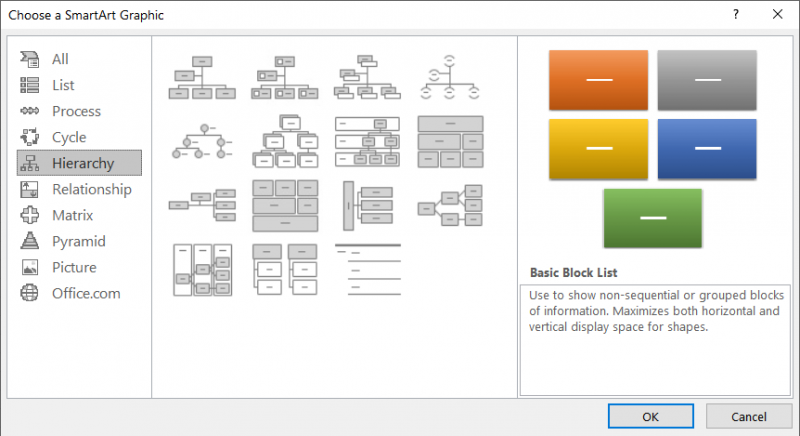Please Note: This article is written for users of the following Microsoft Excel versions: 2007, 2010, 2013, 2016, 2019, and 2021. If you are using an earlier version (Excel 2003 or earlier), this tip may not work for you. For a version of this tip written specifically for earlier versions of Excel, click here: Creating an Organization Chart.
Written by Allen Wyatt (last updated June 12, 2024)
This tip applies to Excel 2007, 2010, 2013, 2016, 2019, and 2021
One of the tools available in Excel is the ability to create organization charts. How you create one depends on the version of Excel you are using. Start by displaying the Insert tab of the ribbon. In the Illustrations group, click the SmartArt tool. Excel displays the Choose a SmartArt Graphic dialog box. At the left of the dialog box click Hierarchy to see the types of organization charts available. (See Figure 1.)

Figure 1. The Choose a SmartArt Graphic dialog box.
If you are using Excel 2007 there are seven types of hierarchy charts available. In Excel 2010 and later versions the number is fifteen. Regardless of the version you are using, the first type of hierarchy chart available is the traditional organization chart. Click that chart (or one of the others, if you prefer) and click OK. Excel adds the chart to your worksheet, along with a bunch of different tools on the Design and Format tabs of the ribbon.
Organization charts are made up of shapes and lines. Lines are automatically added or removed as you add or remove shapes. If you would like to change the formatting of any of the elements in the organization chart, right-click on the element and choose Format Shape from the Context menu.
ExcelTips is your source for cost-effective Microsoft Excel training. This tip (6118) applies to Microsoft Excel 2007, 2010, 2013, 2016, 2019, and 2021. You can find a version of this tip for the older menu interface of Excel here: Creating an Organization Chart.

Professional Development Guidance! Four world-class developers offer start-to-finish guidance for building powerful, robust, and secure applications with Excel. The authors show how to consistently make the right design decisions and make the most of Excel's powerful features. Check out Professional Excel Development today!
Background pictures are repeated over and over again (tiled) by Excel. If you want them to not be tiled, you may be out ...
Discover MoreGraphics can really add pizzazz to a worksheet, but they can also present some drawbacks. If you want to get rid of all ...
Discover MoreWant to "see through" an image you place on a worksheet? You can do so by using the steps in this tip.
Discover MoreFREE SERVICE: Get tips like this every week in ExcelTips, a free productivity newsletter. Enter your address and click "Subscribe."
There are currently no comments for this tip. (Be the first to leave your comment—just use the simple form above!)
Got a version of Excel that uses the ribbon interface (Excel 2007 or later)? This site is for you! If you use an earlier version of Excel, visit our ExcelTips site focusing on the menu interface.
FREE SERVICE: Get tips like this every week in ExcelTips, a free productivity newsletter. Enter your address and click "Subscribe."
Copyright © 2025 Sharon Parq Associates, Inc.
Comments